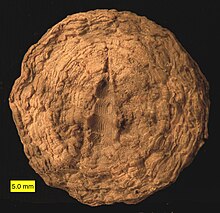Pleurodictyum
Appearance
| Pleurodictyum | |
|---|---|

| |
| P. americanum from the Givetian Kashong Shale (Hamilton Group) of Livingston County, New York | |

| |
| Reverse side | |
| Scientific classification | |
| Domain: | Eukaryota |
| Kingdom: | Animalia |
| Phylum: | Cnidaria |
| Class: | †Tabulata |
| Family: | †Favositidae |
| Genus: | †Pleurodictyum Goldfuss 1829 |
| Species: | †P. americanum
|
| Binomial name | |
| †Pleurodictyum americanum Roemer 1876
| |
Pleurodictyum is an extinct genus of tabulate corals, characterized by polygonal corallites.[1] Colonies commonly encrust hard substrates such as rocks, shells and carbonate hardgrounds.[2]
Distribution
[edit]Fossils of Pleurodictyum have been found in:[3]
- Silurian
Argentina, Australia, Bolivia, Tajikistan, and the United States (Kentucky, Wisconsin)
- Devonian
Algeria, Australia, Bolivia, Brazil, Canada (Ontario), China, Colombia (Floresta Formation, Altiplano Cundiboyacense), the Czech Republic, France, Germany, Luxembourg, New Zealand, South Africa, Spain, Tajikistan, Turkey, the United Kingdom, United States (Indiana, Kentucky, Michigan, New York, Ohio, Pennsylvania, Tennessee), and Venezuela
- Carboniferous
Czech Republic, Mexico, and the United States (Georgia)
References
[edit]- ^ Pandolfi, J.M.; Burke, C.D. (1989). "Environmental distribution of colony growth form in the favositid Pleurodictyum americanum". Lethaia. 22 (1): 69–84. Bibcode:1989Letha..22...69P. doi:10.1111/j.1502-3931.1989.tb01170.x.
- ^ Brett, C.E.; Cottrell, J.F. (1982). "Substrate specificity in the Devonian tabulate coral Pleurodictyum". Lethaia. 15 (3): 247–262. Bibcode:1982Letha..15..247B. doi:10.1111/j.1502-3931.1982.tb00648.x.
- ^ Pleurodictyum at Fossilworks.org
Categories:
- Tabulata
- Prehistoric Hexacorallia genera
- Devonian animals of Africa
- Devonian animals of Asia
- Paleozoic animals of Australia
- Paleozoic invertebrates of Europe
- Paleozoic invertebrates of North America
- Devonian Canada
- Carboniferous Mexico
- Silurian United States
- Devonian United States
- Carboniferous United States
- Fossils of Georgia (U.S. state)
- Devonian animals of South America
- Silurian Argentina
- Silurian Bolivia
- Devonian Bolivia
- Devonian Brazil
- Devonian Colombia
- Fossils of Colombia
- Silurian first appearances
- Late Devonian animals
- Carboniferous extinctions
- Fossil taxa described in 1829
- Paleozoic life of Ontario
- Floresta Formation
- Devonian cnidarians
- Prehistoric cnidarian stubs
- Hexacorallia stubs
- Devonian animal stubs
